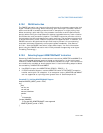
Vol. 3 8-65
MULTIPLE-PROCESSOR MANAGEMENT
8.10.2 PAUSE Instruction
The PAUSE instruction can improves the performance of processors supporting Intel
Hyper-Threading Technology when executing “spin-wait loops” and other routines
where one thread is accessing a shared lock or semaphore in a tight polling loop.
When executing a spin-wait loop, the processor can suffer a severe performance
penalty when exiting the loop because it detects a possible memory order violation
and flushes the core processor’s pipeline. The PAUSE instruction provides a hint to
the processor that the code sequence is a spin-wait loop. The processor uses this hint
to avoid the memory order violation and prevent the pipeline flush. In addition, the
PAUSE instruction de-pipelines the spin-wait loop to prevent it from consuming
execution resources excessively and consume power needlessly. (See
Section
8.10.6.1, “Use the PAUSE Instruction in Spin-Wait Loops,” for more information
about using the PAUSE instruction with IA-32 processors supporting Intel Hyper-
Threading Technology.)
8.10.3 Detecting Support MONITOR/MWAIT Instruction
Streaming SIMD Extensions 3 introduced two instructions (MONITOR and MWAIT) to
help multithreaded software improve thread synchronization. In the initial imple-
mentation, MONITOR and MWAIT are available to software at ring 0. The instructions
are conditionally available at levels greater than 0. Use the following steps to detect
the availability of MONITOR and MWAIT:
• Use CPUID to query the MONITOR bit (CPUID.1.ECX[3] = 1).
• If CPUID indicates support, execute MONITOR inside a TRY/EXCEPT exception
handler and trap for an exception. If an exception occurs, MONITOR and MWAIT
are not supported at a privilege level greater than 0. See
Example 8-23.
Example 8-23. Verifying MONITOR/MWAIT Support
boolean MONITOR_MWAIT_works = TRUE;
try {
_asm {
xor ecx, ecx
xor edx, edx
mov eax, MemArea
monitor
}
// Use monitor
} except (UNWIND) {
// if we get here, MONITOR/MWAIT is not supported
MONITOR_MWAIT_works = FALSE;
}


















